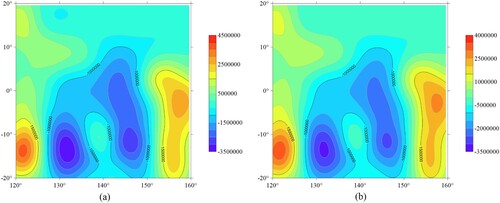Figures & data
Figure 1. Isoline maps of the total magnetic field B at an altitude of 150 km according to the source model data [Citation14] obtained by (a) transformation using spherical harmonics and (b) solution of the inverse problem using modified S-approximations; (c) heat map of value differences between source model data and the result of S-approximations; (d) frequency histogram of value differences between (a) and (b).
![Figure 1. Isoline maps of the total magnetic field B at an altitude of 150 km according to the source model data [Citation14] obtained by (a) transformation using spherical harmonics and (b) solution of the inverse problem using modified S-approximations; (c) heat map of value differences between source model data and the result of S-approximations; (d) frequency histogram of value differences between (a) and (b).](/cms/asset/89a0e760-16e3-4165-b219-7bf41d4e3d91/gipe_a_2018427_f0001_oc.jpg)
Figure 2. Isoline maps of the total magnetic field B at an altitude of 120 km according to the source model data [Citation14] obtained by (a) transformation using spherical harmonics and (b) analytic downward continuations within modified S-approximations; (c) heat map of value differences between (a) and (b); (d) frequency histogram of value differences between (a) and (b).
![Figure 2. Isoline maps of the total magnetic field B at an altitude of 120 km according to the source model data [Citation14] obtained by (a) transformation using spherical harmonics and (b) analytic downward continuations within modified S-approximations; (c) heat map of value differences between (a) and (b); (d) frequency histogram of value differences between (a) and (b).](/cms/asset/cb8ed617-e26e-476b-969c-a14fe9800f0d/gipe_a_2018427_f0002_oc.jpg)
Figure 3. Isoline maps of the total magnetic field B at an altitude of 90 km according to the source model data [Citation14] obtained by (a) transformation using spherical harmonics and (b) analytic downward continuations within modified S-approximations; (c) heat map of value differences between (a) and (b); (d) frequency histogram of value differences between (a) and (b).
![Figure 3. Isoline maps of the total magnetic field B at an altitude of 90 km according to the source model data [Citation14] obtained by (a) transformation using spherical harmonics and (b) analytic downward continuations within modified S-approximations; (c) heat map of value differences between (a) and (b); (d) frequency histogram of value differences between (a) and (b).](/cms/asset/143d6fcb-1227-4f77-89dd-607524b07dde/gipe_a_2018427_f0003_oc.jpg)
Figure 4. Isoline maps of the total magnetic field B at an altitude of 60 km according to the source model data [Citation14] obtained by (a) transformation using spherical harmonics and (b) analytic downward continuations within modified S-approximations; (c) heat map of value differences between (a) and (b); (d) frequency histogram of value differences between (a) and (b).
![Figure 4. Isoline maps of the total magnetic field B at an altitude of 60 km according to the source model data [Citation14] obtained by (a) transformation using spherical harmonics and (b) analytic downward continuations within modified S-approximations; (c) heat map of value differences between (a) and (b); (d) frequency histogram of value differences between (a) and (b).](/cms/asset/0bba1460-e192-4cc8-b10e-07d46849096e/gipe_a_2018427_f0004_oc.jpg)
Figure 5. Isoline maps of the total magnetic field B on the surface according to the source model data [Citation14] obtained by (a) transformation using spherical harmonics and (b) analytic downward continuations within modified S-approximations; (c) heat map of value differences between (a) and (b); (d) frequency histogram of value differences between (a) and (b).
![Figure 5. Isoline maps of the total magnetic field B on the surface according to the source model data [Citation14] obtained by (a) transformation using spherical harmonics and (b) analytic downward continuations within modified S-approximations; (c) heat map of value differences between (a) and (b); (d) frequency histogram of value differences between (a) and (b).](/cms/asset/fb450441-edc6-4a3c-9f0b-d520534d40db/gipe_a_2018427_f0005_oc.jpg)
Figure 6. Quantitative maps of the distribution of equivalent sources, using modified S-approximations at depths of (a) 1 km, (b) 10 km below the relief.

Table 1. Descriptive statistics for data on the total magnetic field at different altitudes according to the spherical harmonics model (L), the model of S-approximations (S), and the difference between them (D).
